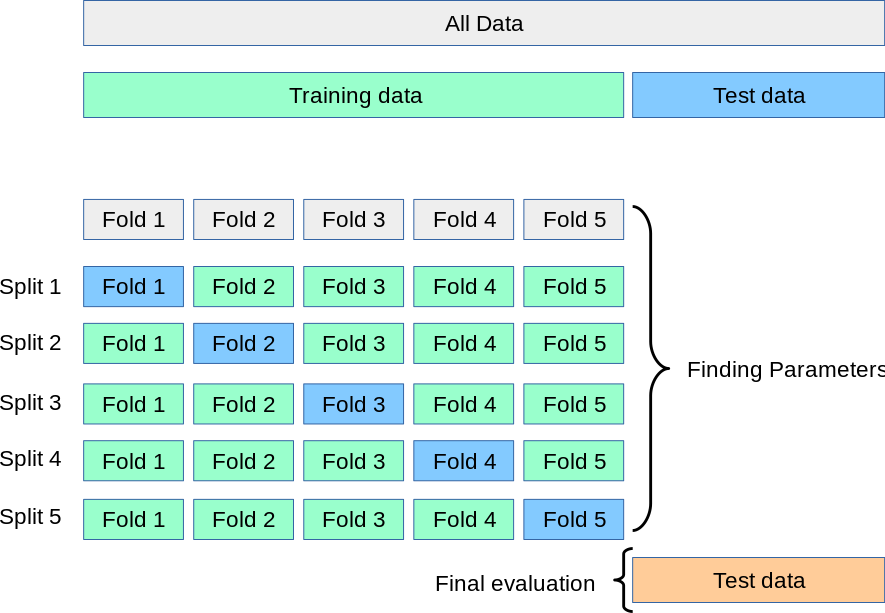模型评估
二分类模型:交叉验证;准确率、召回率、 F 1 F_1 F1、阈值、ROC & AUC
多分类模型:交叉验证;准确率、召回率、 F 1 F_1 F1
回归模型:均方误差(MSE)、 R 2 R^2 R2
聚类模型:轮廓系数
评估方法
留出法
留出法(Hold-Out):直接将数据集划分为两个互斥的集合,分别作为训练集核测试集,训练出模型后用测试集来评估其测试误差。作为对泛化误差的度量
数据集的划分要尽可能数据分布的一致性,避免分布差异造成对结果的影响。单次的留出法得到的结果往往不够可靠,应当采用若干次随机化分、重复进行试验评估后取均值作为留出法的评估结果。
局限性:
- 若划分的训练集较大,训练模型更接近于原数据集训练的模型,但会因测试集较小,造成评估结果不准确
- 若划分的测试集较大,训练出的模型与原数据集训练的模型有较大差异,则会降低评估结果的保真性
自助法
自助法(Bootstrapping):直接以自助采样法为基础,一定程度上降低了数据集规模。
自助法产生的数据集改变了原数据集的分布,会造成估计偏差,当数据集较大时,留出法和交叉验证更常用。
交叉验证法
交叉验证(Cross-Validation):是一种评估泛化性能的统计学方法。
K折交叉验证
K折交叉验证(K-Fold Cross-Validation,KFCV):数据被划分为k份,将其中k-1份数据作为训练集,另外一份作为测试集,重复训练k次。每次都取不同的训练集,最终将模型在k次迭代中的到的得分取平均值作为总体得分。

from sklearn.model_selection import cross_val_score
from sklearn.linear_model import LogisticRegression
from sklearn.datasets import load_iris
iris = load_iris()
logistic = LogisticRegression()
scores = cross_val_score(logistic, iris.data, iris.target)
score.mean()
'''
OUT:
0.9733333333333334
'''
注:cross_val_score 默认执行3次交叉验证,可以通过设定cv参数来修改折数
K折交叉验证无法处理偏斜数据集以及标签集中排列的数据集,这时可以使用分层K折交叉验证。
分层K折交叉验证
分层K折交叉验证(Stratified K-Fold Cross-Validation):划分数据,使每个折中类别之间的比例与整个数据集中的比例相同。
import numpy as np
from sklearn.model_selection import StratifiedKFold
X = np.array([[1, 2], [3, 4], [1, 2], [3, 4]])
y = np.array([0, 0, 1, 1])
skf = StratifiedKFold(n_splits=2)
for train_index, test_index in skf.split(X, y):
print("TRAIN:", train_index, "TEST:", test_index)
X_train, X_test = X[train_index], X[test_index]
y_train, y_test = y[train_index], y[test_index]
'''
OUT:
TRAIN: [1 3] TEST: [0 2]
TRAIN: [0 2] TEST: [1 3]
'''
交叉策略
交叉验证分离器
sklearn允许提供一个交叉验证分离器(Cross-Validation Splitter)作为cv参数,cv用于指定使用什么样的交叉验证方法。
from sklearn.model_selection import KFold
kfold = KFold(n_splits=5, shuffle=True, random_state=0)
scores = cross_val_score(logistic, iris.data, iris.target, cv=kfold)
scores.mean()
'''
OUT:
0.9533333333333334
'''
注:shuffle=True:打乱数据
留一法交叉验证
留一法(Leave-One-Out):提供训练/测试索引以拆分训练/测试集中的数据。每个样本用作测试集(单例)一次,其余样本构成训练集。
from sklearn.model_selection import LeaveOneOut
loo = LeaveOneOut()
scores = cross_val_score(logistic, iris.data, iris.target, cv=loo)
scores.mean()
'''
OUT:
0.9666666666666667
'''
打乱划分交叉验证
打乱划分交叉验证(Shuttle-Split Cross-Validation):生成索引以将数据拆分为训练集和测试集。
from sklearn.model_selection import ShuffleSplit
shuffle = ShuffleSplit(test_size=.5, train_size=.5, n_splits=10)
scores = cross_val_score(logistic, iris.data, iris.target, cv=shuffle)
scores.mean()
'''
OUT:
0.9560000000000001
'''
打乱划分交叉验证可以设定迭代次数,还有另外一种分层形式名为StratifiedShuffleSplit,可以为分类任务提供更可靠的结果。
分组交叉验证
分组交叉验证(Group Cross-Validation):同一组不会出现在两个不同的折叠中(不同组的数量必须至少等于折叠的数量)。在每个折叠中不同组的数量大致相同的意义上,折叠是近似平衡的。
import numpy as np
from sklearn.model_selection import GroupKFold
X = np.array([[1, 2], [3, 4], [5, 6], [7, 8]])
y = np.array([1, 2, 3, 4])
groups = np.array([0, 0, 2, 2])
group_kfold = GroupKFold(n_splits=2)
for train_index, test_index in group_kfold.split(X, y, groups):
print("TRAIN:", train_index, "TEST:", test_index)
X_train, X_test = X[train_index], X[test_index]
y_train, y_test = y[train_index], y[test_index]
'''
OUT:
TRAIN: [0 1] TEST: [2 3]
TRAIN: [2 3] TEST: [0 1]
'''
性能度量
对于二分类问题的评估,一种最全面的表示方法是使用混淆矩阵。
混淆矩阵

from sklearn.linear_model import LogisticRegression
from sklearn.model_selection import train_test_split
from sklearn.metrics import confusion_matrix
from sklearn.datasets import load_digits
digits = load_digits()
y = digits.target == 9
X_train, X_test, y_train, y_test = train_test_split(digits.data, y, random_state=0)
logistic = LogisticRegression(C=.1).fit(X_train,y_train)
pre_logistic = logistic.predict(X_test)
confusion = confusion_matrix(y_test, pre_logistic)
print("Condusion = matrix: \n{}".format(confusion))
'''
OUT:
Condusion matrix:
[[402 1]
[ 6 41]]
'''
精度/错误率
精度: A c c u r a c y = T P + T N T P + T N + F P + F N Accuracy = \frac{TP+TN}{TP+TN+FP+FN} Accuracy=TP+TN+FP+FNTP+TN
错误率: E r r o r R a t e = F P + F N T P + T N + F P + F N Error Rate = \frac{FP+FN}{TP+TN+FP+FN} ErrorRate=TP+TN+FP+FNFP+FN
查准/查全率
准确(查准)率: 被预测为正例的样本中有多少是真正的正例
P
r
e
c
i
s
i
o
n
=
T
P
T
P
+
F
P
Precision = \frac{TP}{TP+FP}
Precision=TP+FPTP
召回(查全)率: 正类样本中有多少被预测为正类
R
e
c
a
l
l
=
T
P
T
P
+
F
N
Recall = \frac{TP}{TP+FN}
Recall=TP+FNTP
from sklearn.metrics import precision_score, recall_score
P = precision_score(y_test, pre_logistic)
R = recall_score(y_test, pre_logistic)
print(
"Precision Score: {}".format(P),
"\nRecall Score: {}".format(R)
)
'''
OUT:
Precision Score: 0.9761904761904762
Recall Score: 0.8723404255319149
'''
P-R曲线

P-R图可以直观地显示出学习器在样本总体上的查准率与查全率,若一个学习器的曲线(蓝色C)被另一个学习器的曲线(橙色B或黑色A)完全”包住“,则认为后者的性能优于前者。若两个学习器的曲线(橙色B与黑色A)发生了交叉,则需要在具体的查准率或查全率条件下比较,但通常认为一个学习器的P-R曲线的下面积在一定程度上表征了两率取得双高的比例。
import numpy as np
import matplotlib.pyplot as plt
from sklearn.metrics import precision_recall_curve
precision, recall, thresholds = precision_recall_curve(y_test, logistic.predict_proba(X_test)[:,1])
plt.plot(recall,precision)
plt.title('Precision/Recall Curve')
plt.xlabel('Recall Score')
plt.ylabel('Precision Score')
plt.show()
注:输出如下图

F 1 F_1 F1度量
对准确率和召回率进行综合度量的方法被称为**
F
1
F_1
F1-分数**(F-Score)或**
F
1
F_1
F1-度量**(F-Measure),它是调和平均值(一种用于概率数据的平均数):
F
1
=
2
⋅
P
r
e
s
i
i
s
o
n
⋅
R
e
c
a
l
l
P
r
e
s
i
i
s
o
n
+
R
e
c
a
l
l
=
2
⋅
T
P
2
⋅
T
P
+
F
P
+
F
N
F_1 = 2·\frac{Presiison·Recall}{Presiison+Recall} = \frac{2·TP}{2·TP+FP+FN}
F1=2⋅Presiison+RecallPresiison⋅Recall=2⋅TP+FP+FN2⋅TP
from sklearn.metrics import f1_score
F1 = f1_score(y_test, pre_logistic)
print("F1 Score: \n{}".format(F1))
'''
OUT:
F1 Score:
0.9213483146067415
'''
性能报告
from sklearn.metrics import classification_report
print(classification_report(y_test, pre_logistic))
'''
OUT:
precision recall f1-score support
False 0.99 1.00 0.99 403
True 0.98 0.87 0.92 47
accuracy 0.98 450
macro avg 0.98 0.93 0.96 450
weighted avg 0.98 0.98 0.98 450
'''
阈值
阈值(thresholds):用于权衡准确率与召回率,降低阈值会在增加召回率的同时降低精度。
准确率-召回率曲线(Precision-Recall Curve):能够计算P-R曲线。precision_recall_curve函数返回一个列表,包含按顺序排列的所有可能的阈值对应的准确率和召回率。这个函数需要真实标签与预测标签的不确定度,由decision_funciton或predict_proba给出
from sklearn.metrics import precision_recall_curve
precision, recall, thresholds = precision_recall_curve(y_test, logistic.predict_proba(X_test)[:,1])
def plot_precision_recall_vs_thresholds(precision, recall, thresholds):
plt.plot(thresholds, precision[:-1], 'b--', label='Precision')
plt.plot(thresholds, recall[:-1], 'g-', label='Recall')
plt.xlabel('Thresholds')
plt.legend(loc=3)
plt.ylim([0,1])
plot_precision_recall_vs_thresholds(precision, recall, thresholds)
plt.show()
注:输出如下图

提高阈值可以让去曲线向准确度更高的方向移动,但同时会降低召回率。增大阈值,大多数被划分为正类的点都是真正例(TP)。随着准确率的升高,模型越能够保持较高的召回率,则模型越好。
ROC & AUC
受试者工程特征曲线(Receiver Operating Characteristics Curve,ROC):是评估二元分类器质量的常用方法,与P-R曲线类似,ROC曲线考虑了给定分类器的所有可能的阈值,但它显示的是假正例率(False Positive Rate,FPR)与真正例率(True Positive Rate,TPR)。FPR、TPR可以使用roc_curve计算。
我们根据学习器预测结果对样例排序,按此顺序逐个把样本作为正例进行预测,每次计算出两个重要量的值,分别以它们为横、纵坐标作图,就得到了ROC曲线。
TPR: R e c a l l = T P T P + F N Recall = \frac{TP}{TP+FN} Recall=TP+FNTP
FPR: R e c a l l = F P T N + F P Recall = \frac{FP}{TN+FP} Recall=TN+FPFP
from sklearn.metrics import roc_curve
fpr, tpr, thresholds = roc_curve(y_test, logistic.predict_proba(X_test)[:,1])
def plot_roc_curve(fpr, tpr, thresholds):
plt.plot(fpr, tpr, label="ROC Curve")
plt.plot([0,1], [0,1], 'k--')
# 找到最接近于0的阈值
close_zero = np.argmin(thresholds)
plt.plot(fpr[close_zero], tpr[close_zero], 'o', markersize=10,
label='thresholds zero', fillstyle='none', c='k', mew=2)
plt.xlabel('Flase Prositive Rate')
plt.ylabel('True Prositive Rate')
plt.legend(loc=4)
plot_roc_curve(fpr, tpr, thresholds)
plt.show()
注:输出如下图

由图可见,TPR(召回率)越高,分类器产生的FPR(假正例)就越多,虚线表示纯随机分类器的ROC曲线,一个优秀的分类器应该离这条线越远越好(左上角)。
ROC / P-R 选择:
当正例非常少见或者更关注假正例而不是假反例时,应该选择PR曲线,反之则是ROC曲线。
与P-R曲线一样,希望有一个指标能综合评价ROC曲线,有一个方法是测量曲线下面积,通常被称为AUC(Area Under The Curve),我们可以利用roc_auc_score函数来计算ROC曲线下的面积。面积较大模型,其性能越好。
from sklearn.metrics import roc_auc_score
roc_auc_score(y_test, pre_logistic)
'''
OUT:
0.9349295179768755
'''
建议在不平衡数据集上评估模型时使用AUC,AUC没有使用默认阈值,因此为了在高AUC的模型中得到有用的分类结果,可能还需要调节决策阈值。
均方误差
均方误差(Mesn Squared Error,MSE):回归模型最常用的评估指标之一。
M
S
E
=
1
2
∑
i
=
1
n
(
y
^
i
−
y
i
)
2
MSE = \frac{1}{2}\sum_{i=1}^n(\hat{y}_i-y_i)^2
MSE=21i=1∑n(y^i−yi)2
其中,
n
n
n 是样本的数量,
y
i
y_i
yi 是样本
i
i
i 的真实值,
y
^
i
\hat{y}_i
y^i 是模型对
y
i
y_i
yi 的预测值,MSE是预测值和真实值距离的平方和,值越大对应模型性能越差。在sklearn中应该使用 neg_mean_squared_error 参数,它是MSE的像相反数。
R 2 R^2 R2
决定系数(
R
2
R^2
R2):代表目标向量的变化中有多少能通过模型进行解释。
R
2
R^2
R2 得分越接近1,代表模型性能越好。
R
2
=
1
−
∑
i
=
1
n
(
y
i
−
y
^
i
)
2
∑
i
=
1
n
(
y
i
−
y
‾
)
2
R^2 = 1-\frac{\sum_{i=1}^n(y_i-\hat{y}_i)^2}{\sum_{i=1}^n(y_i-\overline{y})^2}
R2=1−∑i=1n(yi−y)2∑i=1n(yi−y^i)2
其中,
y
i
y_i
yi 表示样本
i
i
i 的真实性,
y
^
i
\hat{y}_i
y^i是样本
y
i
y_i
yi 的预测值,
y
‾
\overline{y}
y 是目标向量的平均值。
轮廓系数
轮廓系数(Silhouette Coefficient):可以用来衡量聚类模型的质量。轮廓系数取值范围为[-1,1],取值越接近1则说明聚类性能越好,相反,取值越接近-1则说明聚类性能越差,取值为0时说明有簇重叠。
第
i
i
i 个样本的轮廓系数的计算公式为:
s
i
=
b
i
−
a
i
m
a
x
(
a
i
,
b
i
)
s_i = \frac{b_i-a_i}{max(a_i,b_i)}
si=max(ai,bi)bi−ai
其中,
s
i
s_i
si 是样本
i
i
i 的轮廓系数,
a
i
a_i
ai 是样本
i
i
i 与同类的所有样本间的平均距离,
b
i
b_i
bi 是样本
i
i
i 与来自不同分类的最近聚类的所有样本间的平均距离。
轮廓系数不能作为不同聚类模型间的对比依据,对于簇结构为凸的数据轮廓系数值高,而对于簇结构非凸的数据,轮廓系数值低。























 3418
3418

 被折叠的 条评论
为什么被折叠?
被折叠的 条评论
为什么被折叠?










